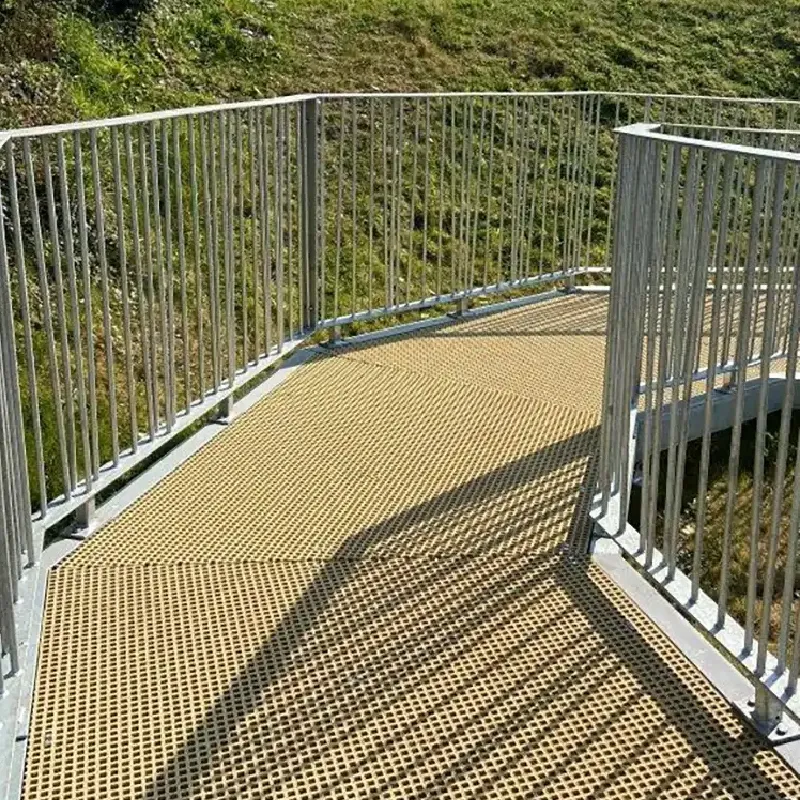loading...
- No. 9, Xingyuan South Street, Dongwaihuan Road, Zaoqiang County, Hengshui, Hebei, China
- admin@zjcomposites.com
- +86 15097380338
- Welcome to visit our website!
Durable and Lightweight FRP Handrail Systems for Safety and Support
The Advantages of FRP Handrail Systems
In recent years, the construction and design industries have increasingly turned to innovative materials to enhance safety, durability, and aesthetics. One such material that has gained popularity is Fiberglass Reinforced Plastic (FRP). Among its many applications, FRP handrail systems have emerged as a sophisticated solution for various settings, including commercial buildings, industrial facilities, and public spaces. This article explores the benefits, applications, and features of FRP handrail systems.
What is FRP?
Fiberglass Reinforced Plastic (FRP) is a composite material made from a polymer matrix reinforced with fibers, typically glass. This combination results in a material that is both lightweight and extremely strong, making it suitable for a variety of applications, particularly where corrosion resistance and structural integrity are critical.
Durability and Longevity
One of the foremost advantages of FRP handrail systems is their exceptional durability. Unlike traditional materials such as wood or metal, FRP does not rot, corrode, or degrade when exposed to harsh environmental conditions. This resistance to weather elements and chemical exposure makes FRP an ideal choice for outdoor installations, industrial settings, and locations prone to moisture. As a result, FRP handrails can maintain their structural integrity and appearance for many years, significantly reducing maintenance and replacement costs.
Safety Features
Safety is paramount in any architectural design, and FRP handrail systems excel in this area. The non-conductive nature of FRP makes it a safe option for environments where electrical hazards may be present, such as in power plants or facilities with heavy machinery. Furthermore, FRP handrails can be designed to meet or exceed safety codes and standards, ensuring that they provide reliable support and protection for users in various applications. The inherent slip-resistant surface of FRP also enhances safety, reducing the risk of accidents in wet or slippery conditions.
frp handrail system

Aesthetic Versatility
In addition to their functional benefits, FRP handrail systems offer significant aesthetic flexibility. Available in a range of colors and finishes, FRP can be tailored to complement any architectural style or design theme. This versatility allows architects and designers to integrate handrails seamlessly into their projects without compromising visual appeal. Moreover, FRP can be molded into intricate shapes and designs, providing creative options that are often limited with traditional materials.
Lightweight Yet Strong
Another notable benefit of FRP handrails is their lightweight composition. This characteristic simplifies installation, as lighter materials can be more easily transported and maneuvered during the construction process. Despite their lightness, FRP handrailing systems do not compromise on strength and can withstand significant loads and stresses. As a result, they are suitable for both residential and commercial applications, ranging from staircases and walkways to balconies and terraces.
Eco-Friendly Solution
As sustainability becomes an increasingly important consideration in construction, FRP handrail systems are emerging as an eco-friendly option. The manufacturing process for FRP is typically less energy-intensive compared to metal production, and its longevity reduces waste over time. Additionally, many manufacturers are now producing FRP from recycled materials, further enhancing its environmental appeal.
Conclusion
In summary, FRP handrail systems represent a modern solution for a range of architectural and safety challenges. Their durability, safety features, aesthetic versatility, lightweight design, and eco-friendly properties make them an attractive choice for builders and designers alike. As industries continue to seek innovative materials to meet the demands of contemporary construction, FRP handrail systems stand out as a reliable and forward-thinking option. With all these advantages, it is no surprise that FRP technology is becoming a preferred choice in the design and construction of handrail systems. Whether for commercial, industrial, or residential use, FRP offers a compelling combination of functionality and style.
-
Transform Your Spaces with FRP Grating SolutionsNewsNov.04,2024
-
The Versatility and Strength of FRP RodsNewsNov.04,2024
-
The Excellence of Fiberglass Water TanksNewsNov.04,2024
-
The Benefits of FRP Grating for Your ProjectsNewsNov.04,2024
-
Elevate Your Efficiency with FRP Pressure VesselsNewsNov.04,2024
-
Welcome to the World of FRP Pressure VesselsNewsOct.12,2024
-
Unveiling the Future of Filtration: Why FRP Filter Vessels are a Game ChangerNewsOct.12,2024
